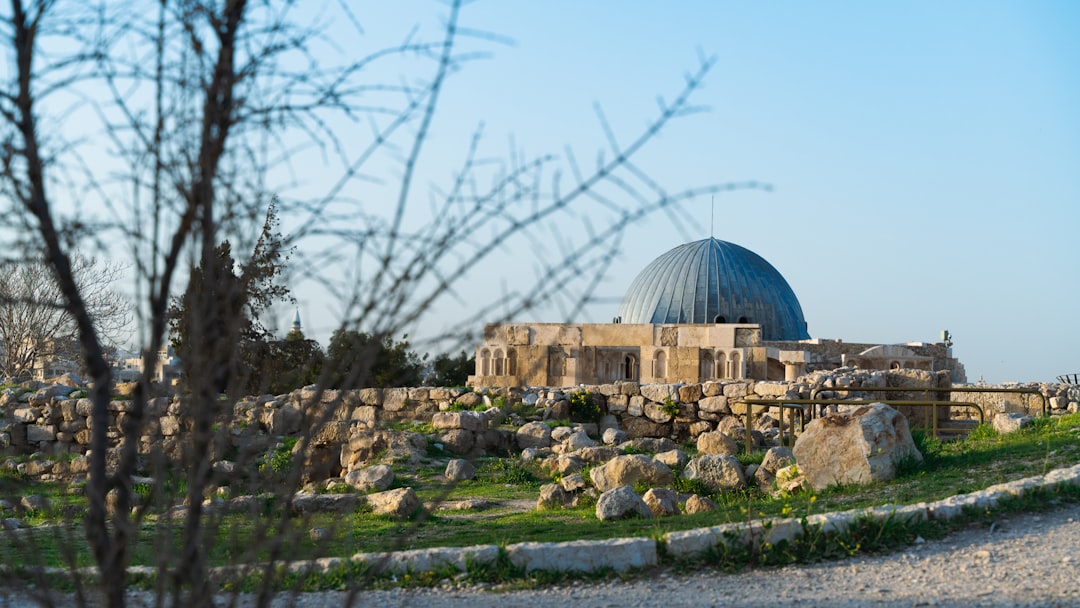Navigating Middle East Travel After Iran-Israel Tensions A Practical Guide
Navigating Middle East Travel After Iran-Israel Tensions A Practical Guide - Assessing Travel Risks in the Volatile Middle East Region

The Middle East region remains highly volatile, particularly after the recent tensions between Iran and Israel. Travelers to the region must exercise extreme caution and closely monitor official travel advisories, as the political climate can change rapidly, leading to border closures, security concerns, and potential unrest. While the risks are highest in areas near borders and major cities, with proper planning and research, travelers can still have a safe and enjoyable experience in the region.
According to a recent study, geopolitical risk has a significant negative influence on financial markets in the Middle East, leading to heightened volatility and economic instability.
The ongoing conflict between Israel and Hamas has resulted in the halt of international tourism to Israel, causing major disruptions to travel plans in the region.
The Middle East region, particularly areas near borders, major cities, and regions with a history of conflict, pose elevated security risks for travelers, including the potential for sudden protests, demonstrations, and violence.
Travelers are advised to exercise extreme caution, especially at night or in crowded areas, and to avoid areas with known tensions or conflicts between neighboring countries.
Registering with one's embassy, closely monitoring local news and official travel advisories, and having emergency contact information and flight plans readily available are crucial precautions for travelers in the Middle East.
Despite the heightened risks, the Middle East region remains an alluring destination for many travelers, and with proper planning, research, and caution, tourists can still enjoy a safe and rewarding experience in the region.
What else is in this post?
- Navigating Middle East Travel After Iran-Israel Tensions A Practical Guide - Assessing Travel Risks in the Volatile Middle East Region
- Navigating Middle East Travel After Iran-Israel Tensions A Practical Guide - Flexible Booking Strategies for Seamless Trip Planning
- Navigating Middle East Travel After Iran-Israel Tensions A Practical Guide - Regional Airlines: Flight Updates and Route Adjustments
- Navigating Middle East Travel After Iran-Israel Tensions A Practical Guide - Enhanced Security Protocols at Major Middle East Airports
- Navigating Middle East Travel After Iran-Israel Tensions A Practical Guide - Government Travel Advisories: Staying Informed and Safe
- Navigating Middle East Travel After Iran-Israel Tensions A Practical Guide - Alternative Destinations Beyond the Conflict Zone
Navigating Middle East Travel After Iran-Israel Tensions A Practical Guide - Flexible Booking Strategies for Seamless Trip Planning
Navigating the Middle East after recent regional tensions can be a delicate endeavor, but flexible booking strategies can help ensure a seamless travel experience. The provided guidance suggests planning itineraries that cover a range of destinations, from the biblical sites of Israel and Jordan to the cultural gems of Turkey and Iran. While accommodation costs vary, budget-conscious travelers can find affordable options, particularly in Turkey and Iran. Additionally, booking guided tours can offer a stress-free way to explore the region, with the added benefits of expert local knowledge and efficient logistics. When planning a Middle East adventure, it's crucial to consider seasonal factors and cultural sensitivities to ensure a safe and enriching journey.
The average price of a hostel bed in countries like Turkey and Iran can be as low as $15-30 USD per night, making them affordable options for budget-conscious travelers.
Booking with companies that offer flexible travel dates or cancellation policies with minimal fees can provide a significant advantage when planning a trip to the Middle East, where unexpected events or schedule changes are common.
Timing a trip to the Middle East is crucial, as the summer season can be extremely hot in certain countries, such as Iran, while Turkey experiences its busiest tourist season during the summer months.
When backpacking through the Middle East for a month, popular destinations like Jordan, Lebanon, and Iran offer diverse experiences, while countries like Dubai, Jordan, and Israel tend to be more expensive for accommodation.
Due to cultural differences, it's essential for travelers to be mindful and take necessary precautions, such as using hidden pouches or money belts and being discreet when handling cash or credit cards, to ensure the safety of their valuables.
Guided tours in the Middle East can offer a stress-free and enjoyable travel experience, with benefits such as expert knowledge, reliable transportation, and seamless logistics, making them an effective option for travelers seeking a hassle-free trip.
Navigating Middle East Travel After Iran-Israel Tensions A Practical Guide - Regional Airlines: Flight Updates and Route Adjustments

As the tensions between Iran and Israel continue to escalate, airlines in the region have been forced to make significant adjustments to their flight routes and schedules. Several major carriers, including El Al, Air India, and others, have temporarily suspended flights to and from Tel Aviv as a precautionary measure. This has resulted in longer and more circuitous routings for some flights, leading to increased travel disruptions and delays throughout the Middle East.
Despite the temporary disruptions, the region's major airlines, such as Emirates, Qatar Airways, and Etihad, have been working to resume their regular flight operations as soon as possible. However, the ongoing conflict has prompted concerns over the safety of aircraft traveling through the affected airspace, leading airlines to exercise caution and implement contingency plans to ensure the well-being of their passengers and crews.
Regional airlines have been nimble in adjusting their flight routes to navigate the airspace closures in the Middle East due to the tensions between Iran and Israel.
Some carriers have reported rerouting flights to avoid the affected areas, leading to longer flight times.
Airlines have had to make tough decisions on whether to suspend flights to certain destinations in the region, with carriers like India's Air India halting services to and from Israel as a precautionary measure.
The disruptions have had a cascading effect, as airlines that typically traverse the Iranian airspace, a vital corridor for flights between Europe and Asia, have been forced to find alternative routes, leading to increased fuel consumption and operational costs.
Aviation experts suggest that the current instability in the Middle East could persist, and regional airlines may need to further adjust their networks and operational strategies to minimize the impact on passenger travel and cargo movements.
The flight cancellations and rerouting have resulted in significant travel disruptions for passengers, with some experiencing lengthy delays or having to alter their itineraries due to the evolving situation in the region.
Regional airlines are closely monitoring the situation and collaborating with aviation authorities to ensure the safety of their operations, while also exploring ways to mitigate the financial impact of the disruptions on their businesses.
The conflict has presented a unique challenge for regional airlines, as they must balance passenger safety, operational efficiency, and commercial viability in their decision-making process regarding flight routes and schedules.
Industry analysts suggest that the regional airlines' ability to adapt quickly and effectively to the changing conditions in the Middle East will be a key factor in their resilience and competitiveness in the years to come.
Navigating Middle East Travel After Iran-Israel Tensions A Practical Guide - Enhanced Security Protocols at Major Middle East Airports
Heightened security measures have been implemented at major airports across the Middle East in response to the escalating tensions between Iran and Israel. Airports in countries like the UAE, Saudi Arabia, and Jordan have invested heavily in advanced security technologies, including enhanced screening procedures, increased security personnel, and the deployment of biometric systems. These efforts aim to safeguard the safety and security of both passengers and airport staff, ensuring a seamless travel experience amid the regional geopolitical challenges.
Major Middle Eastern airports have installed advanced facial recognition and iris scanning systems to enhance passenger screening and identification, reducing the risk of security breaches.
Automated tray return systems with built-in explosive trace detection have been implemented at security checkpoints, allowing for faster and more thorough screening of carry-on luggage.
Airport perimeter security has been bolstered with the deployment of radar-based intrusion detection systems and drone detection technology to safeguard against unauthorized access.
Biometric boarding gates equipped with fingerprint or palm vein recognition are being used to streamline the passenger boarding process while maintaining tight access control.
Data analytics and artificial intelligence algorithms are being leveraged to identify potential security threats by analyzing passenger behavior and travel patterns in real-time.
Joint security operations centers have been established, integrating data from various surveillance systems to provide a comprehensive, cross-agency view of airport security.
Canine units trained to detect explosives have been integrated into the security protocols, complementing the technology-driven measures to ensure a multi-layered approach to threat detection.
Airports are investing in redundant, hardened communications infrastructure to ensure the reliability and resilience of security systems, even in the event of a cyber attack or other disruptions.
Extensive security personnel training programs have been implemented, equipping staff with the latest techniques and best practices for identifying and responding to evolving security threats.
Navigating Middle East Travel After Iran-Israel Tensions A Practical Guide - Government Travel Advisories: Staying Informed and Safe

A Practical Guide
In the aftermath of the recent Iran-Israel tensions, the U.S. State Department has issued a global travel advisory, urging increased caution for Americans traveling internationally. The advisory highlights concerns over potential terrorist attacks, demonstrations, and military operations in the Middle East, particularly in Israel, the West Bank, and Gaza. Travelers are advised to remain vigilant and exercise heightened awareness when visiting the region.
The State Department has also raised its COVID-19 travel advisory for the United Arab Emirates to the highest level, advising against all travel to the country. This comes as the department continues to monitor the evolving security situation and provide updated guidance to U.S. citizens. Travelers planning trips to the Middle East are encouraged to closely follow government advisories and take necessary precautions to ensure their safety.
The U.S.
State Department has issued a global travel advisory, urging increased caution for U.S.
citizens traveling internationally due to ongoing conflicts in the Middle East.
The advisory specifically highlights active military operations, rocket and mortar fire in Gaza and the Gaza periphery, posing risks to travelers.
The U.S.
has also warned of the threat of missile or drone attacks and terrorism in the United Arab Emirates, elevating concerns for U.S.
citizens and interests in the Gulf region.
Amid heightened tensions, the U.S.
has urged Americans to leave Iraq immediately, citing the potential for further escalation following the killing of Iranian General Qassim Suleimani.
The State Department has raised its COVID-19 travel advisory for the United Arab Emirates to the highest level, "Do Not Travel," due to the pandemic situation.
The global travel alert is considered one of the most urgent issued in recent years, reflecting the extremely high tensions throughout the Middle East.
In addition to the Israel-Hamas conflict, the State Department has warned of potential terrorist attacks, demonstrations, and violent actions against U.S.
citizens and interests in the region.
The department reminds travelers to be vigilant and cautious, as security incidents in the Middle East can occur without warning.
The State Department's travel advisories are designed to provide timely and accurate information to help U.S.
citizens make informed decisions about their international travel.
Analysts suggest that the current advisory highlights the need for travelers to closely monitor government-issued guidance and assess the risks before embarking on Middle East journeys.
Navigating Middle East Travel After Iran-Israel Tensions A Practical Guide - Alternative Destinations Beyond the Conflict Zone
As the conflict between Iran and Israel continues, travelers are seeking alternative destinations beyond the Middle East conflict zone. Some airlines have been forced to adjust their routes, leading to longer flight times and higher costs. However, the Middle East remains an alluring region, with countries like the UAE, Egypt, and Morocco emerging as popular alternatives for travelers looking to explore the cultural and culinary delights of the area without the risk of getting caught in the crossfire. While the situation remains fluid, travel experts advise staying informed and exercising caution when planning trips to the region.
The recent Iran-Israel conflict has forced airlines to take longer routes to avoid the conflict zone, leading to increased flight times and fuel consumption.
Morocco has seen a surge in tourism as travelers seek alternative destinations beyond the conflict zone, offering a safe and stable option for Middle East travel.
The United Arab Emirates has emerged as a popular transit hub for flights rerouted from the conflict zone, with Dubai's airport experiencing a spike in traffic.
Egypt's Sharm El-Sheikh, known for its stunning Red Sea resorts, has seen a significant increase in visitors seeking a peaceful escape from the regional tensions.
Airlines have had to adjust their schedules and routes to navigate the complexities of the Iran-Israel conflict, with some carriers temporarily suspending flights to affected airports.
The conflict has led to a heightened focus on security measures at airports in the region, with enhanced screening and additional security checks for travelers.
Tourism in Israel has suffered a major setback, with international visitors opting for alternative destinations in the Middle East due to the ongoing tensions.
Iran's airspace, a vital corridor for flights between Europe and Asia, has become a source of concern for the global aviation industry, as any disruptions could have far-reaching consequences.
The conflict has highlighted the importance of flexibility and adaptability for airlines and travel providers, as they navigate the ever-changing landscape of regional conflicts.
Destinations like Oman and Jordan have seen an influx of travelers seeking safe and stable alternatives to the conflict zone, offering a range of cultural and natural attractions.
The Iran-Israel conflict has underscored the need for comprehensive travel insurance and contingency planning for travelers, as the situation in the region remains fluid and unpredictable.
